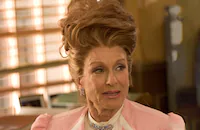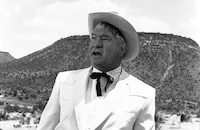The Steagle
Cast & Crew
Paul Sylbert
Richard Benjamin
Warren Munson
William Farley
Tanya
Cloris Leachman
Film Details
Technical Specs

Synopsis
On 21 October 1962, literature professor Harold Weiss returns from a convention to his suburban New York home. On the train, he spots an Asian woman who reminds him of a girl he wooed during his time in Iwo Jima during World War II. When a man doing a crossword puzzle wonders about the 1943 merger between the Philadelphia Eagles and Pittsburgh Steelers football teams, Hal informs him in stunning detail about the team, officially called the Philpitt Eagles but popularly labeled the Steagles. At dinner with his wife Rita and their children, Annie and Sammy, Hal mentions, as he customarily does, that one day he might move the family to California. Later, as Rita listens nervously to a television report announcing that President Kennedy will give an emergency broadcast the next day, a fidgety Hal walks outside to pretend he is a famous baseball pitcher. In the morning, Hal teaches a dull class, after which he amuses his friend Max Levine in the cafeteria by flattering the various senior faculty in his constant bid for advancement. Hal then attends a faculty interdisciplinary meeting, where he wanders from discussion group to group, both impressing and annoying the senior staff with his erudite intrusions. He offers a ride home to a Florence Maguire, the wife of a colleague, and on the way they stop to listen to Kennedy's speech. The radio broadcast, about the impending Cuban Missile Crisis and its accompanying threat of worldwide nuclear war, terrifies Hal and Florence. Upon hearing Kennedy call upon Soviet premier Nikita Khrushchev to abandon his course of world domination, Florence begins sobbing, but when she asks if Hal thinks they will all die, he responds, "Who gives a shit?" Shocked at himself, Hal sees a mushroom cloud in his mind, and when Florence laughs, they suddenly kiss, then make love. Afterward, Hal longs to get home, but an ardent Florence feels transported. The following morning, when Hal wakes Rita with a kiss, she hurtles out of bed to make sure her home and family are still intact, after which Hal calms her by feeding her cereal like a child. When he arrives at his office, he finds Florence waiting, impassioned, but he rebuffs her. He begins his next class with a droning lecture, but upon hearing a jet's sonic boom outside, launches into a diatribe about Willie Mays, then delivers the rest of his speech in Pig Latin, earning the students' applause. Dr. Worthington Payne hears of the students' enthusiasm and visits Hal's office to praise him, but Hal, instead of currying favor with the older professor, calls him a "schmuck" and then runs through the halls jumping with glee. Spontaneously, Hal boards a plane to Chicago, introducing himself as Hal Winters to his amiable seatmate, Marty Panesh. The two men have dinner together, at which Marty breaks down in drunken tears about his miserable family and work life, recalling his German wartime lover. As a television news show announces that the Defense Department plans to sink any ships bringing arms to Cuba, Marty confesses that he sometimes wishes the missiles would destroy them all. Later, Hal calls his ex-lover, Marie Voleska, who welcomes him to her home. On the way there he relives his many trips to her house when he was a young soldier, and upon spotting Marie inside, dances with her as if no time had passed. After they make love, however, she reveals that she is actually Marie's daughter Louise, who has heard tales of Hal, whom she describes as her mother's "whole life." Hal then flies to Las Vegas, and on the flight reassures a frightened reverend, Dr. Ernest Barrow, that the world will not end momentarily. Hal inroduces himself to Ernest as George Guynemer, Jr., son of the famous World War I flying ace. In Vegas, Hal relishes driving down the Strip, then ogles the girls at his hotel pool. When Joan Thompson and Marcy Martin sit with him, he impresses Joan, though Marcy remains indifferent when he claims to be Guynemer, in town to meet with Hollywood executives about a remake of Hell's Angels . The women agree to join him for dinner, and as he awaits them in the lounge, he spots Ernest, wearing a secular suit and drinking alcohol. Supporting the nervous man's desire for "one last chance" to try out another lifestyle before the presumed end of the world, Hal invites him along on a night of drunken gambling. Hours later, the foursome park at a construction site outside the city, where a lecherous Ernest chases Joan down one path, while Hal and Marcy saunter down another. Sitting, Hal mentions that he saw the devastation of Hiroshima, while Marcy asks if there is a part for her in his film. When he makes love to her, she demands that he repeat "I, Lawrence of Arabia, am taking you, Marcy." The next day, on his flight to Los Angeles, Hal claims to Mark Forbes and his seductive wife that he is Robert Hardy, the real-life inspiration for the film character "Andy Hardy." In Hollywood, he wanders the Walk of Fame, ending up at the Brown Derby restaurant. Upon visiting the men's room, Hal find Tall Guy McCoy, an old-time Western sidekick who now believes he is Humphrey Bogart, claiming that the Maltese Falcon is under the sink. Hal plays along, to the annoyance of the other men who are trapped in the room by Tall Guy. Together they attack the other men and are thrown out of restaurant. Tall Guy invites Hal into his classic car, and while they are driving down a Beverly Hills street, the old actor seems to hop out of the moving car. Hal is horrified until Tall Guy reappears, revealing that he has been hanging onto underside of the car in a replay of one of his old stunts. They visit his old studio, where a guard plays along with Tall Guy's fantasy that he is still working. In the dark, they wander the sets, and on a recreated firebombed city street, Hal fantasizes that he is in battle again in Iwo Jima. He and Tall Guy see Nazi soldiers bear down on them and imagine themselves in a full-scale assault, comporting themselves with honor against German, then Japanese, then Colonial-era Indian enemies. In the morning, the police find them sleeping in the car, and inform them that Kennedy has saved the world and the Russians have pulled out of Cuba. Hal heads home, and on the train uses his real name when he meets fellow traveler Matt Mahew. Upon discussing the Cuban crises, Matt states that a better outcome would have been a war that led eventually to peace. When Hal questions him about casualties, Matt responds that death is natural, and if it had not existed, some American businessman would have invented and sold it. As the train passes through the Bronx, Hal recalls all of the women he has been with lately and the identities he has taken on. Finally, he imagines Rita, and when the train stops, he runs through the station in his hurry to reunite with her.

Director
Paul Sylbert
Cast

Richard Benjamin
Warren Munson
William Farley
Tanya

Cloris Leachman
Lisa Cantor
Linnard Lane
Harold Reynolds
Joe Bernard
John Neris
Peter Hobbs
Jean Allison

George Mann
Valorie Armstrong
Jack Bernardi
Susan Tyrrell
Ivor Francis
Suzanne Charny
Susan Kussman
Bernie Massa

Diane Ladd
Frank Christi
Beau Anderson
Henry Oliver
Nick Courtland
Lew Palter

Chill Wills
Tom Conroy
Lawrence Bame
John Hiestand
Colin G. Male
Minta Durfee
Anita Alberts
Alice Nunn
Crew
Bernie Abramson
John Boldroff
Kenneth Borland
Richard Borland
Don Cady
Sammy Cahn
William Campbell
Lisa Cella
Sam Cook
Paul Coons
Jim Di Gangi
Bob Fillis
Wendell Franklin
Fred Gammon
Earl Gilbert
Fred "bud" Giles
Raymond Gosnell
Ronald R. Grow
Burnett Guffey
Norman Hawkins
William Johnson
Harry Korshak
William Kuehl
Tony La Marca
Allen Levine
Joseph E. Levine
Terry Lewis
Cecile Lupton
Robert Magahay
Bill Malley
Pat Marshall
Lillian "lolly" Meltzer
Mac Meltzer
E. Meresca
Gene Milford
John Moio
Jack Morrow
Ned Moss
Fred Myrow
Bill Perrilard
Richard Portman
Herb Rindenow
Ron Riner
Lorraine Roberson
Randy Roberts
Kay Rose
Frank P. Rosenberg
Joe Rubalcava
Bernt G. Saad
Robert Sharp
Allen Snyder
Thomas Stanford
Alpha Steinman
Shirley Strahm
Jule Styne
Anthea Sylbert
Paul Sylbert
Terry Terrill
James Utterback
Roy Woodside
Bruce Wright

Film Details
Technical Specs

Quotes
Trivia
Notes
Paul Sylbert's onscreen credit reads: "Written for the screen and directed by." Although the onscreen credits include a 1971 copyright statement for Avco Embassy Pictures Corp., the film was not registered for copyright. Although Gene Milford is listed as the film editor in all of the Hollywood Reporter production charts and news items, only Thomas Stanford is listed onscreen.
The Cuban Missile Crisis, which precipitates much of the action in The Steagle, occurred in 1962 when the Soviet Union, then headed by Premier Nikita Sergeyevich Khrushchev, built secret intermediate-range missile installations in Cuba. Upon learning of the missiles, U.S. President John F. Kennedy announced a naval blockade around Cuba and proclaimed that any missile launched from there would incur immediate retaliation from the United States. Despite growing tensions and the threat of imminent nuclear war, on October 28, 1962 Khrushchev agreed to dismantle the installations, and disaster was averted.
One of "Harold Weiss's" false identities is that of the son of George Guynemer, a French pilot who rose to fame during World War I for his unparalleled fighting record. The Steagle contains many real-life radio and television audio clips, including President Kennedy's initial speech to the nation about the Cuban situation.
In June 1968, Hollywood Reporter reported that Binder/Howe Productions had purchased Irvin Faust's novel The Steagle, planning for Steve Binder to direct a film version, executive-produced by Binder, Bones Howe and Harry Colomby. In March 1970, a Daily Variety news item noted that Avco Embassy was producing The Steagle and would shoot interiors at the Warner Brothers Studio lot. Other contemporary news items list location shooting sites in Las Vegas, New York City and in Los Angeles, including at the Brown Derby, the Ambassador Hotel and in Hollywood.
The Steagle was the only American feature directed by Paul Sylbert, a production designer and the twin brother of noted art director Richard Sylbert. According to the Hollywood Reporter review, Sylbert worked on the project for three years after acquiring the rights to Faust's book. The film marked the last for Minta Durfee (1889-1975). Married for many years to silent film comedian Roscoe "Fatty" Arbuckle, the actress was a popular comedienne during the 1910s.
Critics were divided in their response to the film; while Los Angeles Times called it "a stunning writing and directing feature debut," Variety criticized the "confusing and rambling storyline and frequently slow-paced and low-key direction."

Miscellaneous Notes
Released in United States 1971
Released in United States on Video April 26, 1990
Released in United States 1971
Released in United States on Video April 26, 1990











